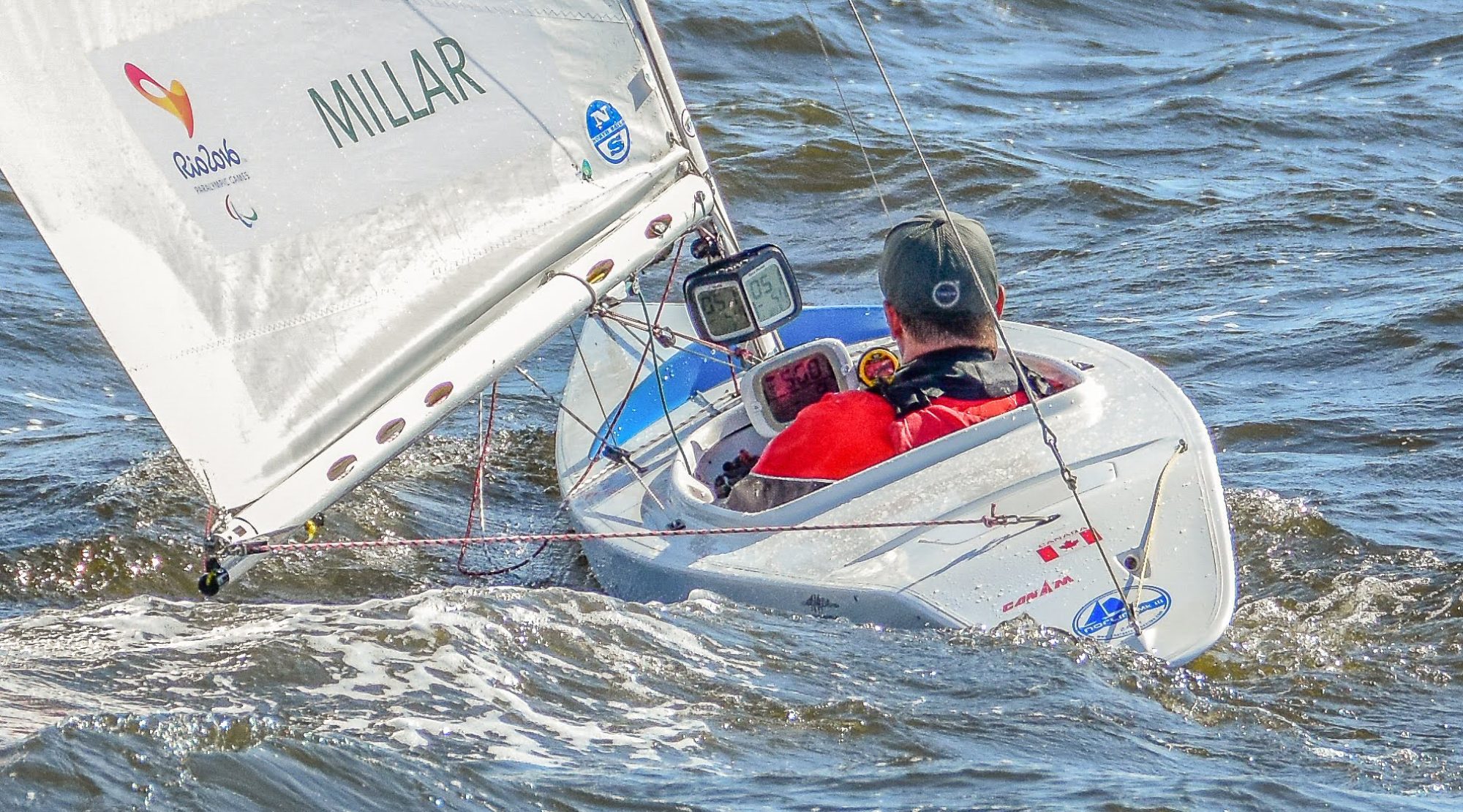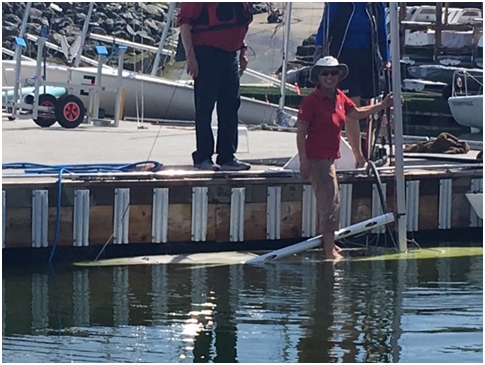Joe Gerlinsky is developing a device that will launch 2.4mR into small lakes.
See some of the photos of the work in progress below.


Canadian 2.4mR Sailing Association
2.4mR Sailboat Class
Joe Gerlinsky is developing a device that will launch 2.4mR into small lakes.
See some of the photos of the work in progress below.
A working manual bilge pump is an essential safety item on a 2.4mR but it is surprising how a little piece of debris can make it non operational. I put in a new manual pump in my older 2.4 last week and thought everything would be fine even though my electric pump was having issues. Dial forward to Sunday. A perfect sunny day for sailing with winds 10 to 12 knots and gusts up to maybe 15 knots.
The pump worked well for the first hour or so. I would pump the boat dry on the runs and then take a little water from the waves going up wind. Then the pump stopped working. I took a few waves and the water was over the floor board. I thought it was prudent to get back to the dock before I really filled up the boat.
Back at the dock we lifted the boat onto its cradle and then I removed the pump to take it to my work bench for disassembly and inspection. The culprit as can be seen in the photo was a very small piece of line which got trapped in the check valve of the pump and wouldn’t let the pump diaphragm do its job. The DIY solution was to go to the dollar store and buy a $1.50 small kitchen strainer and sabotage it to make a strainer for the end of the hose. Pump with strainer is now reinstalled on the boat. The electric bilge pump is repaired too.
I will be insetting strainers on the other 2.4’s in our fleet. Moral of the story. Keep a clean bilge.
Peter Wood
CAN 14

You may be interested in following the construction of a new cold molded 2.4 in your town. Could this be a Canadian first?
A little background: when David was encouraging many to become a 2.4’er I did some Internet searching and found that Hesse Malmonsen’s website which includes plans for cold molded and, yes, stitch and glue 2.4 designs going by the name of Stradivari. Cutting to the chase, I have a neighbour who is a wood boat craftsman and he has agreed to build a cold molded Stradivari Mk IV. His business is called Nomad Boat Building and he has decided to run a Youtube video series on the adventure that has got underway. Here is the link to the first two Youtube videos:
(at this time there is only Mark’s 1/4 scale half hull, but as the project progresses I can likely arrange a project visit during the construction, and of course after we are allowed to return to social gathering)
You are welcome to share this with friends you may know, even other 2.4mRers beyond Cadboro Bay!
Mark
NEWPORT, R.I. (November 8, 2018) – The C. Thomas Clagett, Jr. Memorial Clinic and Regatta is pleased to announce that there will be four recipients for the 2018 Clagett Boat Grant Program.
“We are thrilled that through the fundraising efforts for the Clagett Boat Grant Program we are able to award 2.4mR boats to sailors in the US and in Canada. The US boat is going to the Challenged Sailors program in San Diego, California and the boats going to Canada will be going to sailors in Ontario and Alberta. These boats will bring the total of boats that have been granted through the Clagett Boat Grant Program to six over the three years it has been operating. It is important that adaptive sailors are supported in their important endeavors and through this program we at The Clagett are able to provide opportunities to sailors to pursue their individual goals in sailing,” commented Clagett President and Co-Founder Judy Clagett McLennan.
Louise Anstey
Thankfully, it was a sunny May afternoon when our scheduled day for the floatation test arrived. With the three Ps (planning, people and persistence) we managed to test most of the boats in our fleet. We used the method required by the Class Rules: 35 kg of lead placed in the boat (simulating the sailor’s weight), flood it with water, then rock the boat to remove any trapped air. At this stage, Doug Bell (CAN 68) recorded each partially submerged boat with its proud owner looking on. Doug gave the photo evidence to our Class Measurer, Bruce Millar (CAN 39), for a permanent record of each test.
All eight boats tested that day passed with flying colours.
Being new to the 2.4mR class, I was a bit skeptical of the adequacy of this test. I know it is possible (although not advisable) to submarine a boat in 25 or 30 kts of wind and also that boats can fill up quickly especially when it is wavy, or on a busy start line, or when pumps fail, which they inevitably do. Having flipped and turtled dinghies in Caddy Bay in years past I know how cold that water is! Staying with your boat or, better yet, on top of your boat is very important. So I needed to be sure my 2.4 had plenty of reserve buoyancy. To satisfy myself, my solution was to climb aboard my boat full of water and the 35 kg of lead.
Yes! It remained afloat…..well, awash…..but it did not sink. Just to be sure this was not an anomaly, I performed this same test on three additional boats.
I’m happy. Let’s go sailing.

CAN AM Winter Series: The second year of the 2.4mR CAN-AM winter series is in the books. The final regatta was picture perfect with winds 8 to 13 knots, air temperature 28 degrees Celsius and water temperature about 20 degrees Celsius. Racing was incredibly close throughout the fleet with first and last boats finishing 120 seconds apart. Ironically, the days after the conclusion of the regatta were dead flat calm. The schedule for the 2018 – 2019 CAN Am Winter Series should be available by late May.
2018 Regatta Schedule: As regatta dates, host clubs, and venues are known they are being posted on the class website. The Toronto area regatta schedule is now posted. Royal Victoria Yacht Club is hosting the first Pacific Coast 2.4mR Championship June 16 & 17th. Pointe Claire Yacht Club in Montreal will be hosting our 2018 Canadian Championship August 10, 11, & 12th. Events in the United States which may be of interest to our members are being posted as we become aware of them. Please check the website regularly for all the latest news.
2018 Class Membership and Dues: Our class membership year runs April 1 to March 31. The webmaster has edited the procedures to join the class on line through the website. This requires both renewing and new members to complete the jotform and pay the membership dues through Paypal. Although we do take payment by cheque as well, our preferred payment option is Paypal. Please don’t hand either the class secretary or myself cash at a regatta to pay your membership dues. Although we are honest we are also forgetful so your dues may not be credited to you.
2018 dues are $ 50.00 (same as 2017).
Class Website: We had problems in September 2017 with the host of our class website. Thanks to the tireless work of Aaron Wong-Sing, the website was rebuilt and we continue to receive positive comments from our members, from 2.4mR sailors from other countries, and from sailors in other classes within Canada. Making the job easier for Aaron has been Doug Bell, Dee Smith and Bruce Millar all who have contributed articles to the website. The website is our voice to the sailing community at large so if you have anything you wish to share please pass it to the webmaster.
Buoyancy Tests and Certificates: Regular buoyancy tests are a safety issue. At the 2017 Canada Games two boats failed their initial buoyancy tests and required addition floatation materials before they were permitted to race. It was a good thing because two boats did swamp in the one heavy air race and required assistance in being pumped out. If you do not have a buoyancy certificate for your boat or if your certificate was issued in 2013 or earlier you must be tested before you will be permitted to race in class events in 2018. Contact the class measurer (Bruce Millar) to arrange for a buoyancy test.
Jib Boom Boats: Last winter, Tony Pocklington and Bruce Millar spent time with Bjorner Erikstad (NOR) about the development of jib boom boats. Bjorner has had international success with his jib boom boat and the consensus is that competitive jib boom boats will make 2.4mR sailing accessible to more sailors without diminishing the competitiveness of the fleet. In the future I will ask Bruce to prepare an article on jib boom boats for the website.
Please remember to send your questions, reports, pictures and gripes to the class e-mail address [at][dot]